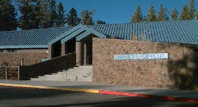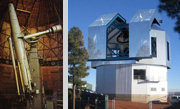
This is an exciting time for solar-stellar research. SORCE and friends are recording the behavior of the third solar minimum measured directly from space. As recently demonstrated by CoRoT, exoplanet discoveries are marching steadily down the mass scale toward the detection of Earths, and by the time of this meeting, Kepler should be revealing many new exoplanets. Solar variations have a demonstrable effect on terrestrial climate on both cycle and longer timescales. Recent studies have been published suggesting solar activity may be subsiding from a century-long grand maximum. Spectroscopic and photometric surveys are finding progressively fainter stars that may be the so-called "solar twins," increasing the sample of genuine proxies for solar behavior.
For these reasons and more, we invite the astronomical community to a three-day discussion of these critical issues. Each session will include invited and contributed talks, typically 30-45 minutes long. After each talk, we will include extended time for discussion and questions, in the spirit of the first Solar Analogs workshop back in 1997. Extended breaks and poster viewing will allow ample time for informal discussions as well.
Registration is open to any scientist working in astronomy, solar physics, climate science, or related field; however, attendance space is limited and registration will be closed if we reach our capacity. The registration fee includes lunch each day and coffee breaks (both served on our campus near the meeting room), an opening reception, the Tuesday conference dinner, and shuttles to and from the meeting hotel downtown.
We will encourage all participants contributing talks or posters to send electronic versions of the presentations for inclusion in an online proceedings, as well as an "executive summary" of the presentations if it is useful (i.e., to explain more fully the content of PowerPoint slides in a talk, or to provide details about an aspect of a poster). The idea is to find a middle ground between ensuring the proceedings have useful detail and burdening presenters with a full-blown "publication." In the proceedings, we will include the talks and posters, discussion transcripts, and technical and layperson summaries of the outcome of the workshop.
 The meeting will be held on the campus of Lowell Observatory, in the
Giclas Lecture Hall of the Steele Visitor Center
(pictured at right). The lecture hall has all necessary
A/V, and wired and wireless Internet is available. Coffee breaks
and poster viewing will be scheduled during each session.
The meeting will be held on the campus of Lowell Observatory, in the
Giclas Lecture Hall of the Steele Visitor Center
(pictured at right). The lecture hall has all necessary
A/V, and wired and wireless Internet is available. Coffee breaks
and poster viewing will be scheduled during each session.
The reception, lunches, Tuesday dinner, and breaks will be served at the meeting site. We will provide attendees with a restuarant and attractions guide as well.
Flagstaff lies at an elevation of 7,000' (2,150m) amid a Ponderosa pine forest at the foot of Arizona's highest mountain range, the San Francisco Peaks, which rise to 12,700' (3,870m) north of town. The city has about 55,000 residents (~75,000 including suburbs). Late September is typically clear and very dry with daytime highs around 75 F (23 C). Due to our high desert climate, nights will be cool (perhaps 40 F, 5 C).
For more information about enjoying your stay here, see the logistics page, or consider going on one of the pre-workshop excursions.
 Lowell Observatory is a private, non-profit research institution founded by
Percival Lowell in 1894. Today the Observatory has grown to over 70 employees
with more than 20 Ph.D. astronomers, and we are presently constructing the 4.2-meter
Discovery Channel Telescope
40 miles from Flagstaff. Over 80,000 visitors attended our astronomy
education programs in 2008.
Lowell Observatory is a private, non-profit research institution founded by
Percival Lowell in 1894. Today the Observatory has grown to over 70 employees
with more than 20 Ph.D. astronomers, and we are presently constructing the 4.2-meter
Discovery Channel Telescope
40 miles from Flagstaff. Over 80,000 visitors attended our astronomy
education programs in 2008.